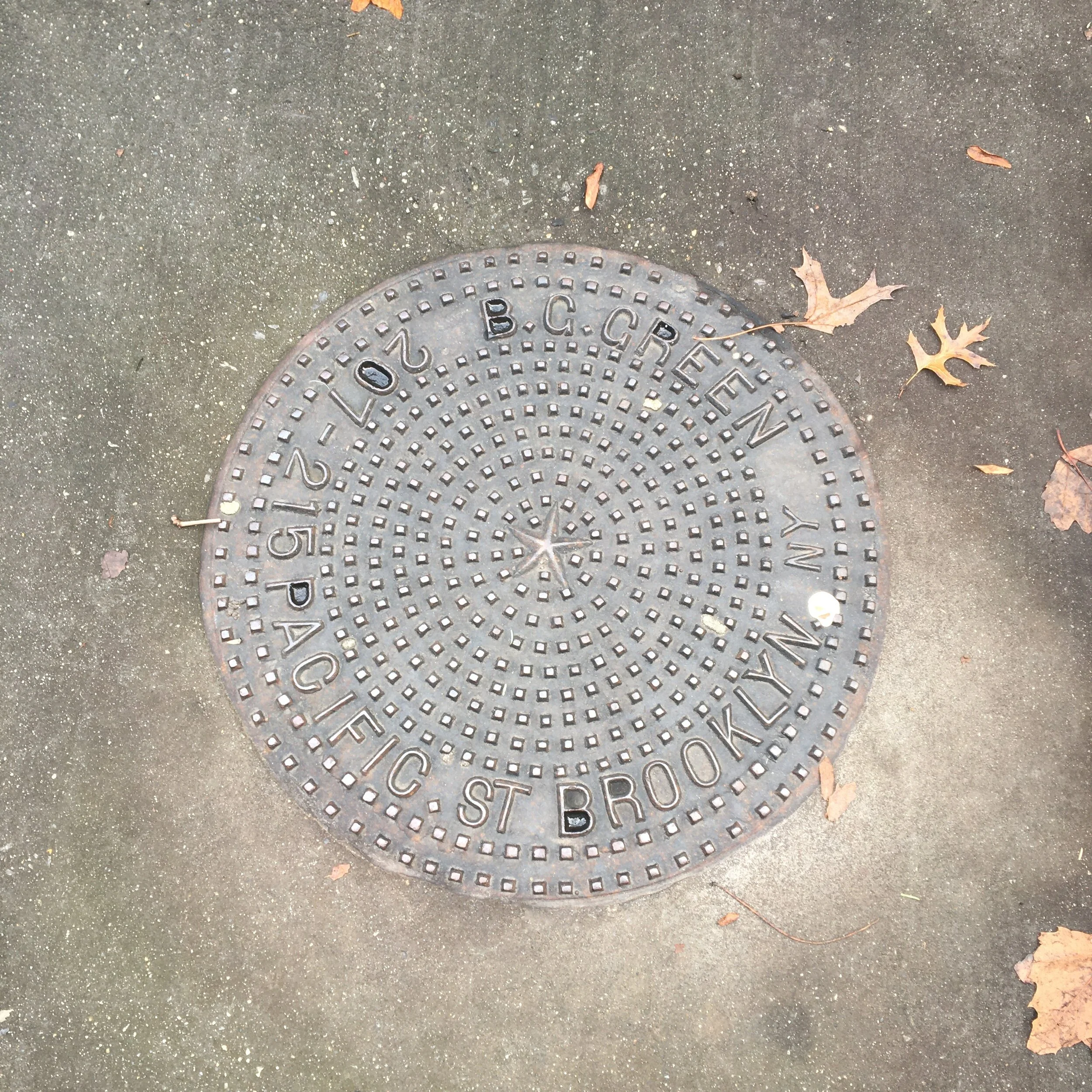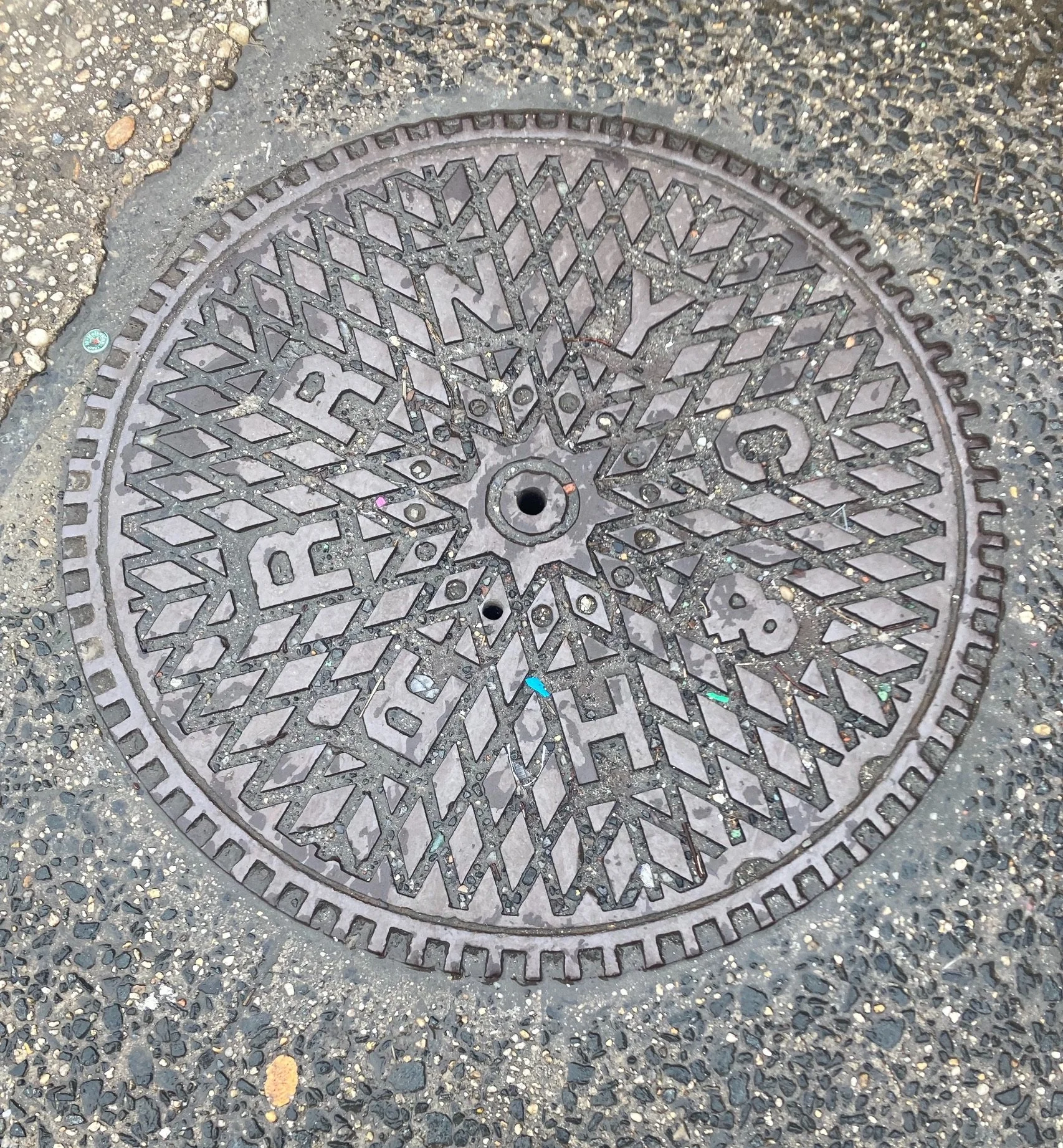Manhole covers and coal chute covers are often strictly utilitarian but they can open a window on local history, or just be interesting to look at. I’ve found these on my travels pre-stroke and post-stroke.
I became interested in this after seeing a photo of a very attractive manhole cover in New Orleans. As much as I like looking up as I move around the city, I have to look down too, being mindful of tripping hazards, and sometimes I’m rewarded with, of all things, an interesting manhole cover.
Old houses in the city were built with coal-fired boilers. Coal would be delivered through coal chutes in the sidewalk in front of the house or through trap doors directly in front of the house. Many coal chute covers have been replaced by concrete plugs. Here’s a coal chute cover in the sidewalk on my block. The address is now in a residential area and recalls a time when New York City was dotted with small foundries and factories.
Manhole cover on Fulton Street in Brooklyn. The lettering is RT SUBWAY NYC. The Fulton Street subway opened in 1936 so this manhole cover is at least that old.
Sewer manhole cover dated 1928 in Mineola, Long Island, near the train station.
Manhole cover on Flatbush Avenue in Brooklyn. The lettering is P.S.C. I.R.T. for Public Service Commission (of the State of New York), Interborough Rapid Transit The section of the subway opened in 1920 so this manhole cover is at least that old.
Brooklyn Union Gas Company manhole on Atlantic Avenue.
Coal chute cover on St. Marks Avenue in Brooklyn.
Tic-tac-toe on a Brooklyn coal chute cover.
Manhole cover on Broadway at East 18 Street in Manhattan. The lettering is P.S.C. M.R.C. for Public Service Commission (of the State of New York), Municipal Railway Corporation. The Broadway subway opened in 1918 so this manhole cover is at least that old. The Municipal Railway built and operated the Broadway subway in Manhattan, the 4 Avenue subway in Brooklyn, and the Manhattan Bridge line and Montague Street tunnel that connected them, for its parent, the Brooklyn Rapid Transit Corporation. In the aftermath of the 1918 Malbone Street wreck that killed 97 people, the BRT was reorganized as the Brooklyn-Manhattan Transit (BMT) and the Municipal Railway was absorbed into it.
Another Brooklyn coal chute cover. I can’t decipher the address.
These aren’t manhole covers but three of the roundels in the walkway on the High Bridge between Manhattan and the Bronx, detailing its history.
The Brooklyn Navy Yard had its own power and sewer systems. Here’s a manhole cover at the Navy Yard.
Sewer manhole, Bobby Wagner Walk at East 91 Street, Manhattan.
Found on Kent Avenue at Broadway, in the Williamsburg section of Brooklyn. BRT stands for Brooklyn Rapid Transit, the operator of streetcars, elevated lines, and subways in Brooklyn and Queens, and later, Manhattan, that became Brooklyn-Manhattan Transit (BMT) in 1923. This is the first time I’ve seen a BRT manhole cover. The BRT electrified its elevated and surface lines between 1900 and 1905. Before the BRT’s Broadway elevated was extended across the Williamsburg Bridge to Manhattan in 1908, it terminated at the Broadway Ferry at Kent Avenue. This portion of the line stood until 1941. I think this manhole dates from the original electrification of the Broadway elevated. Once again, history lies in plain sight.
Seen on the Aqueduct Walk in the Bronx, atop the Old Croton Aqueduct.
Coal chute cover on Broadway between 17 and 18 Streets in Manhattan. Weinstock Bros. was a hardware store that supplied coal chute covers. Go to Weinstock Bros. Hardware - Walter Grutchfield for some history. This cover dates from the 1910s or 1920s.
Water meter cover in Charleston, South Carolina. Photo courtesy Daniel Murphy.
Seen on the Jerome Avenue (west) side of Yankee Stadium.
Coal chute cover in Edward L. Grant Highway, Bronx.
Philadelphia Electric Company, seen on Benjamin Franklin Parkway.
Minimalist manhole cover in Newport, Rhode Island.
A more recent and less minimalist manhole cover, Newport, Rhode Island.
B.R. stands for Borough of Richmond, former name of what is now the Borough of Staten Island. (It’s still Richmond County, though.) Seen on York Avenue, Staten Island.
Seen on Barrow Street, Manhattan.
Manhole cover at East 138 Street and Park Avenue, Bronx. NYC&HRRR stands for New York Central and Hudson River Railroad (the name of the New York Central prior to 1914).
Manhole cover in Berlin, showing various landmarks like the Reichstag, the Brandenburg Gate, and, in the center, the Fernsehturm, a television tower that was the icon of East Berlin. Photo by Bill Briggs.
Subway manhole in Brooklyn, on Metropolitan Avenue between Union Avenue and Lorimer Street. The inscription stands for Public Service Commission - Municipal Railway Corporation. This section of the Canarsie subway dates from 1924.
One of a pair of the same design, seen on Fifth Avenue in Manhattan, near the Metropolitan Museum of Art.
Seen on East 28 Street in Manhattan. This is a “Duplex Safety Coal Hole Cover and Ventilator.”
What was probably a coal chute cover, seen in Hoboken, New Jersey.






























